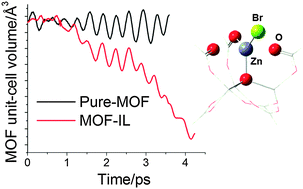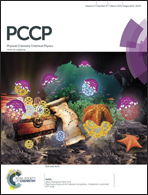On the structural stability of ionic liquid–IRMOF composites: a computational study†
Abstract
The structural stability of isoreticular metal organic frameworks, IRMOF-1 and IRMOF-10, confining ionic liquids (ILs) inside their nano-porous cavities is studied via molecular dynamics (MD) simulations. Imidazolium- and pyridinium-based ILs, including BMI+PF6−, BMI+Br−, BMI+Tf2N−, BMI+DCA−, and BuPy+Tf2N− (BMI+ = 1-butyl-3-methylimidazolium, PF6− = hexafluorophosphate, Br− = bromide, Tf2N− = bis(trifluoromethylsulfonyl)imide, DCA− = dicyanamide, and BuPy+ = N-butylpyridinium), at different loadings are considered. It is found that both IRMOFs are structurally unstable and deform dramatically from their crystal structure in the presence of ILs. The interactions between the metallic parts of IRMOFs and IL anions play a major role in structural disruption and collapse of these MOFs. Thus elongated anions such as Tf2N− and DCA− that can interact with two different metal sites tend to lower IRMOF stability compared to spherical anions such as Br− and PF6−. A further analysis via density functional theory (DFT) and ab initio molecular dynamics (AIMD) simulations lends support to the MD results regarding structural instability of IRMOFs in the presence of ILs.


 Please wait while we load your content...
Please wait while we load your content...